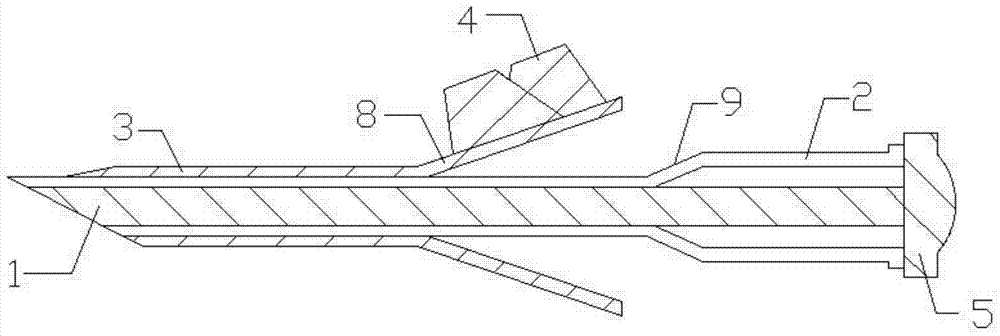Catheter leading-in device
A catheter introduction and needle tube technology, which is applied in the direction of trocars, guide needles, puncture needles, etc., can solve the problems of non-reusable, difficult to be accurate, poor tracking of fistula tubes, etc., and achieve the effect of small trauma and simple operation steps
- Summary
- Abstract
- Description
- Claims
- Application Information
AI Technical Summary
Problems solved by technology
Method used
Image
Examples
Embodiment 1
[0030] Embodiment 1: a kind of catheter introduction device, its structure is as Figure 1-6 Shown: includes needle core 1, needle core 1 is covered with inner needle tube 2, inner needle tube 2 is covered with outer needle tube 3; needle core 1 has a solid structure, and the tail end of needle core 1 is fixedly connected with handle 5; the inner needle tube 2 is Hollow structure, the right side of the inner needle tube 2 is provided with a first variable diameter section 9, the first variable diameter section 9 can be matched with the nipple of the syringe, and the tail of the first variable diameter section 9 is provided with a The flange 6; the outer needle tube 3 is a non-closed hollow structure with side seams, the outer needle tube 3 is provided with two fins 4, and the end of the outer needle tube 3 near the fins 4 is a bell mouth structure 8, which is convenient for catheter introduction .
[0031] The handle 5 is provided with an arc-shaped protrusion that fits the p...
Embodiment 2
[0038] Embodiment 2: a kind of catheter introduction device, it is still structured as Figure 1-6 Shown: The difference from Embodiment 1 is that the introduction device in this embodiment is applied to lumbar drainage.
[0039] In the lumbar drainage operation, routine position, disinfection, draping, skin breaking, puncture (same as the previous operation), after entering the subarachnoid space, withdraw the needle core 1, see the cerebrospinal fluid flowing out through the inner needle tube 2, reinsert it Needle core 1 and keep the position of inner needle tube 2 still, slowly screw the outer needle tube 3 forward clockwise by 3-5mm, then withdraw the inner needle tube 2 together with needle core 1 to confirm the outflow of cerebrospinal fluid again, and pass the shunt tube through the outer The needle tube 3 is inserted into the drainage tube to the desired depth, the fixed drainage tube is withdrawn from the outer needle tube 3 to the body, and separated in the opposite ...
Embodiment 3
[0043] Embodiment 3: a kind of catheter introduction device, it is still structured as Figure 1-6 Shown: The difference from Embodiment 1 is that the introduction device in this embodiment is applied to pleural cavity drainage.
[0044] In pleural cavity drainage, the positioning, disinfection, draping, and puncture methods are the same as the previous methods. After puncturing the chest wall and feeling a breakthrough into the pleural cavity, withdraw the needle core 1, connect the inner needle tube 2 to the syringe for suction or hear the sound of airflow to confirm that it has entered the pleural cavity, withdraw the inner needle tube 2, insert the drainage tube through the outer needle tube 3 to a certain depth, and withdraw The outer needle tube 3 goes out of the body, separates the two wings 4 in the opposite direction to release the outer needle tube 3 from the shunt tube, adjusts the position of the drainage tube, fixes it, wraps it aseptically, connects the drainage ...
PUM
 Login to View More
Login to View More Abstract
Description
Claims
Application Information
 Login to View More
Login to View More - R&D
- Intellectual Property
- Life Sciences
- Materials
- Tech Scout
- Unparalleled Data Quality
- Higher Quality Content
- 60% Fewer Hallucinations
Browse by: Latest US Patents, China's latest patents, Technical Efficacy Thesaurus, Application Domain, Technology Topic, Popular Technical Reports.
© 2025 PatSnap. All rights reserved.Legal|Privacy policy|Modern Slavery Act Transparency Statement|Sitemap|About US| Contact US: help@patsnap.com



